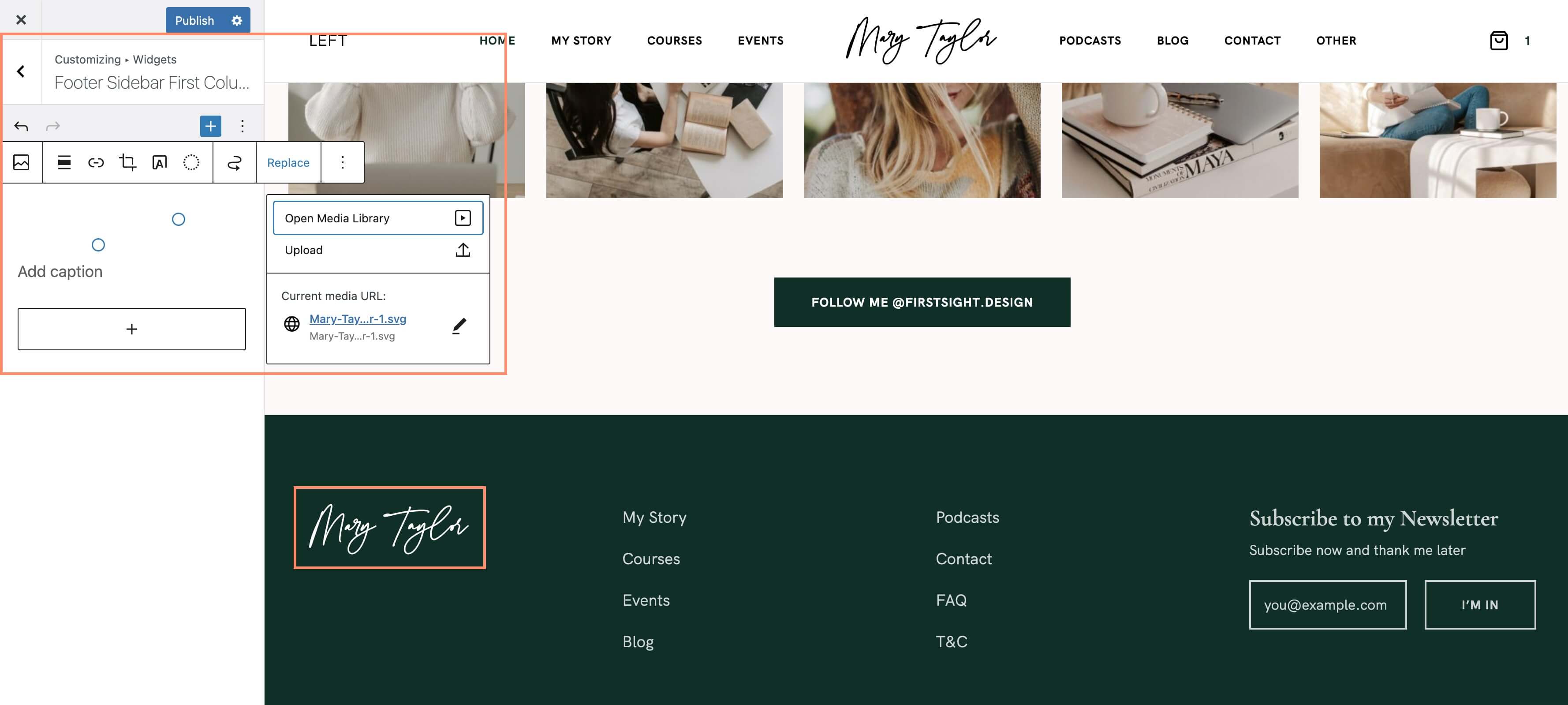1. Support
Thank you so much for choosing Magnetique WordPress Theme. We have put a lot of effort and love creating it. YouTube video installation guide and step-by-step tutorial is available here. In this documentation, we have tried to consider all the important details to run your website successfully. In case you have any questions left, please feel free to submit a support ticket here.
Your feedback on our theme is much appreciated. We would love to make our product even better, so please feel free to get in touch with any suggestions for improvement. Thanks again for your support. We value you!
If you like our work, please rate it. If you are going to rate it with less than 5 stars, please let us know the reason first and we will do our best to improve the theme.


2. Theme Installation
After you’ve installed WordPress on your hosting, download the archive with the purchased theme, unzip it and prepare magnetique.zip and magnetique-child.zip archives. Open your WordPress dashboard.
Go to Appearance > Themes and click on Add New.

Click on Choose File and select the magnetique-child.zip. Click Install Now.

You will see the success message ‘Theme has been installed successfully’, click on the Return to Themes page and do the same for magnetique.zip.

You will see your new magnetie theme and child theme appear in the dashboard. Press the Activate button on your magnetique-child theme, you will work with the magnetique-child theme and do not activate your magnetique theme.

After activation you will be redirected to the ‘Welcome’ page of the theme. Now you need to install all the plugins used in the theme: click on the Install Theme Plugin button.

Select all plugins in the list, choose Select from the dropdown menu and click on the Apply button. Installation process will begin, it might take a couple of minutes, please wait until it's finished.

Once the installation process is finished, you will see a success message ‘All plugins installed and activated successfully’. Make sure all plugins were installed in the Plugins tab in your admin panel.

From your admin panel go to Magnetique > Demo Install.

You should choose the demo you want to import and use for your theme and click on the Import button.

Demo import can take up to 10 minutes, please wait until it's finished. You will see the success message after the demo is installed successfully.

Select ‘Visit site’ you will see that the demo has been installed.


3. Theme Customization
In your admin panel hover on the home icon and select Visit Site.

On top on the page click on Customize and you will see Customization Panel.

In the Customization Panel you can find settings that will be applied to the entire theme. Once you have applied any changes you have to click on the Publish button to apply those changes.

3.1 Logo
Go to Customize > General. Here you can upload your logo. We suggest uploading a dark and a light version of your logo. The size of our logo is 172px x 55px.

3.2 Favicon
Go to Customize > General. In this section you can upload a site icon that will appear in the browser tab.

3.3 Main Theme Colors
Go to Customize > Theme Colors. In this section you can change main theme colors.

3.4 Typography
Go to Customize > Typography. In this section you can change fonts and their settings: size, line height, letter spacing, align. From the Font Family dropdown you can select any Google font you like.

3.5 Social Media
Go to Customize > Social Icons. In this section you can set links to your social media accounts that appear in the header and footer. You can also edit existing social media icons or add new ones.

3.6 Popup
Go to Customize > Popup. In this section you can change the background color of the popup and switch on/off animated line.

3.7 Global Theme Icons
Go to Customize > Global Icons. In this section you can change global theme icons, such as: icons in the subscription form, icons on the shop, etc.

3.8 Header Types
Go to Customize > Header Type. In this section you can change the header of your theme. Just select the option you like more.



3.9 Blog Archive Types
Go to Customize > Blog Archive Type. In this section you can choose the Blog Catalogue page layout. There are two different types, just pick the one you like more.

Default Blog Archive type has a featured post on top of the screen on the colored background.

Typical Blog Archive type has a list layout with sidepanel (optional).

3.10 Single Event
Go to Customize > Single Event. In this section you can set up popup and buttons that appear on the event details page.

3.11 Copyright
Go to Customize > Footer. In this section you can add/edit copyright message that appears in the footer.

3.15 Homepage Settings
Go to Customize > Homepage Settings. In this section you can select the page you’d like to be your homepage.

3.16 WooCommerce
Go to Customize > WooCommerce. In this section you can apply some settings to the WooCommerce functionality: add a store notice, change product catalogue settings, product images and checkout.

Go to your admin panel and select WooCommerce > Settings. In this section you can set up your online store: select/change currency, select payment methods and delivery methods, etc.

4. Popup Settings & Shortcodes
To find the shortcode of the popup go to the admin panel of your there. From the left menu choose Contact > Contact Forms. You will see the list of your contact forms and you can copy the shortcode of each popup from this page.

5. Posts
Go to your admin panel and click on Posts > All Posts. Here you will see the list of all blog posts. To add a new post simply click on the Add New button on top of the screen.

You can choose from two types of the Blog Catalogue page, you can find detailed information in the ‘3.10 Blog Catalogue Types’ section of this documentation.
To set up a Sticky post or any other blog post, hover on its name and click on the Edit action link.

For each post you will need to upload a preview image, it will appear on the blog catalogue page.

For the sticky post you will also need to add an image that will appear on top of the catalogue page or on the right side of the catalogue page. Suggested image size is 1110px*1110px.

After the changes are applied, click on the Update button on the top right corner of the screen to save and apply all changes.
6. Products
Go to your admin panel and click on Products > All Products. Here you will see the list of all products available in the theme shop. To add a new product simply click on the Products > Add New.

To edit an existing product, hover on its name and click on the Edit action link. For each product you should add its name, description, price, you can also add product categories and tags.


Don’t forget to add product image and images to the product gallery, suggested image size is 1052 by 1400px.

7. Pages
Go to your admin panel and click on Pages > All Pages. Here you will see the list of all pages in your theme. To add a new page simply click on the Pages > Add New.
To edit an existing page hover on its name and click on the Edit action link. The majority of the pages are created using Elementor page builder. For such pages you should select Edit with Elementor option.

7.1 Homepage
To edit the homepage you have to find it in the pages list, hover on it and click on Edit with Elementor. To change the hero image, click on the Edit icon.
Select the Side Image in the settings panel on the left of the screen and upload your image to the Choose Image section.

Click on the Select Files button and upload your image. Click on the Insert Media at the bottom of your screen.

After uploading the image or making any other changes, don’t forget to click on the Update button to save the changes.

To edit the Title and Buttons, click on the Edit icon on the correspinding block and make changes in the left side panel.

To edit any other section on the page, click on the Edit icon on the left of the section and make changes in the left side panel. Click on the Update button on the bottom of the screen to save the changes.

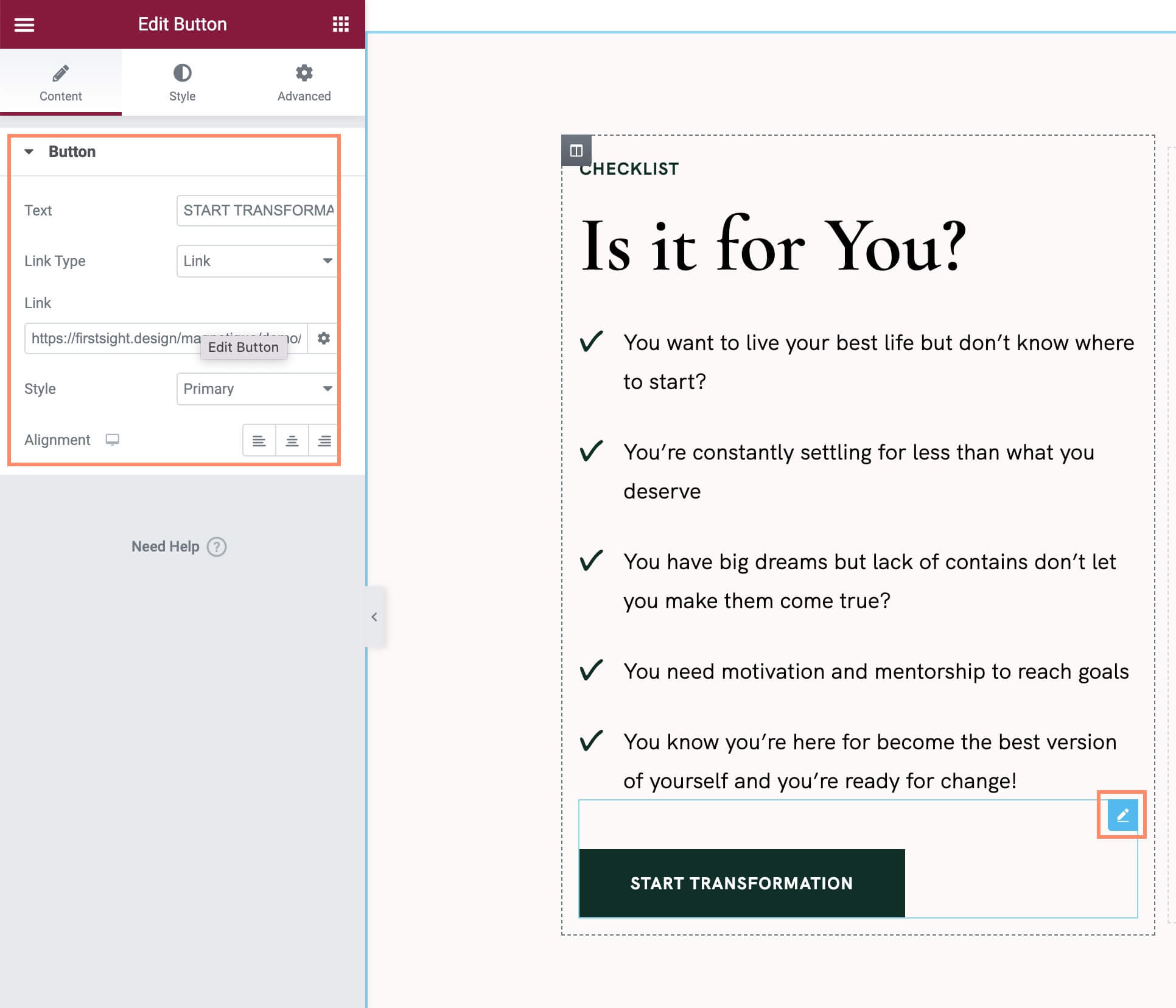
7.2 Events
To edit the events, go to your admin panel and choose My Events > All Events. To add new events, click on the Add new.

To edit existing event, click on the Edit action link under the event's name and make needed changes in the WordPress edit mode.

Please note that you should set the Event date, the date when event will take place. The date when the event page was published will not be visible on the event details page.
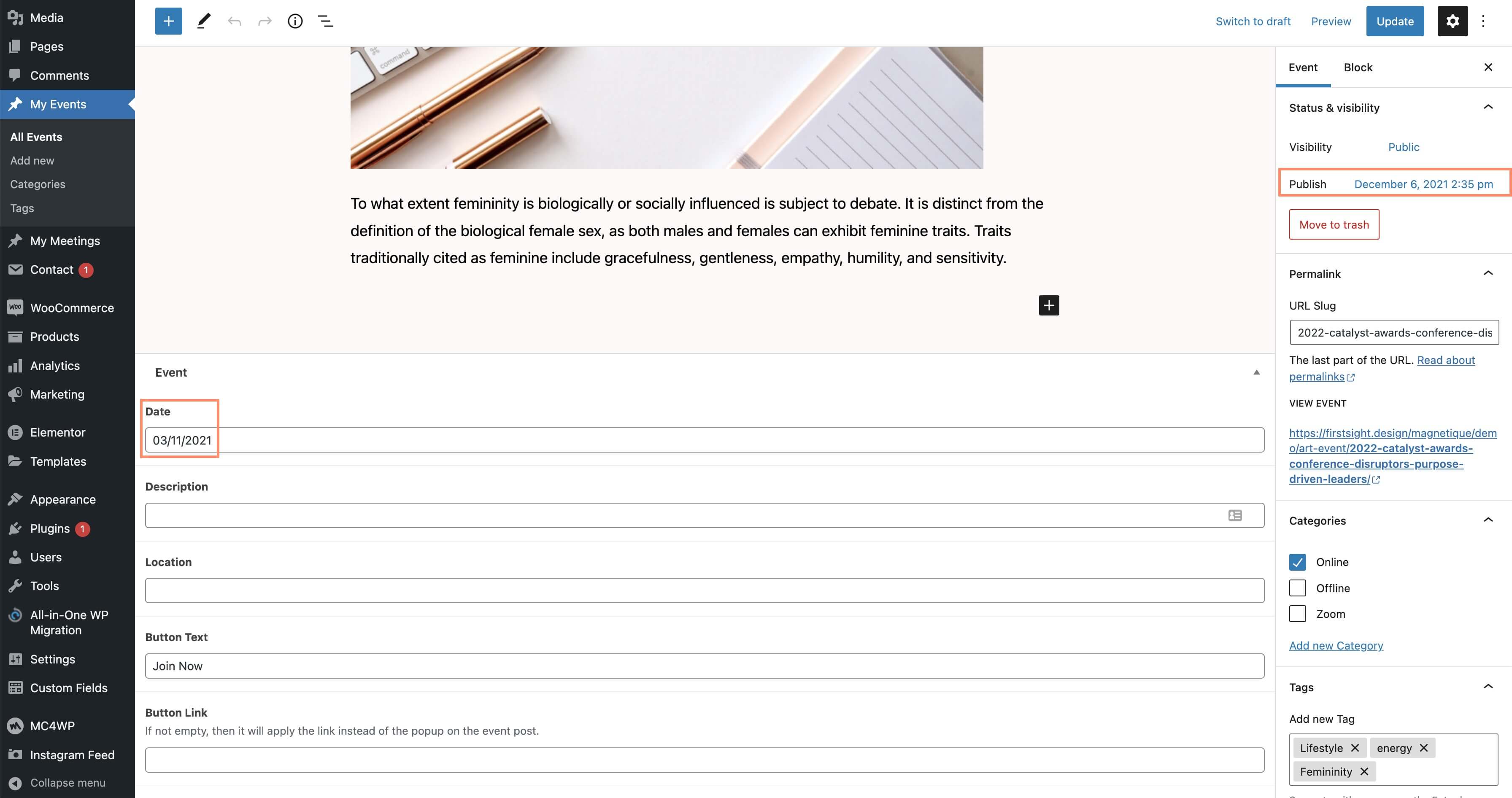
To add/edit events categories, go to My Events > Categories and add new category or edit existing one.

7.3 Podcasts
To edit the podcasts, go to your admin panel and choose Podcasting > All Episodes. To add new podcast, click on the Add new Episode.

To edit existing podcast, click on the Edit action link under the episode name and make needed changes in the WordPress edit mode.

7.4 Zoom Meetings
To edit Zoom meetings, go to your admin panel and choose My Meetings > All Meetings. To add new Zoom meeting, click on the Add new.

To edit existing meeting, click on the Edit action link under the meeting's name and make needed changes in the WordPress edit mode.

7.5 LearnPress: Courses
The theme is compatible with with LearnPress plugin. To edit Courses, go to your admin panel and choose LearnPress > Courses. To add new Course, click on the Add new.
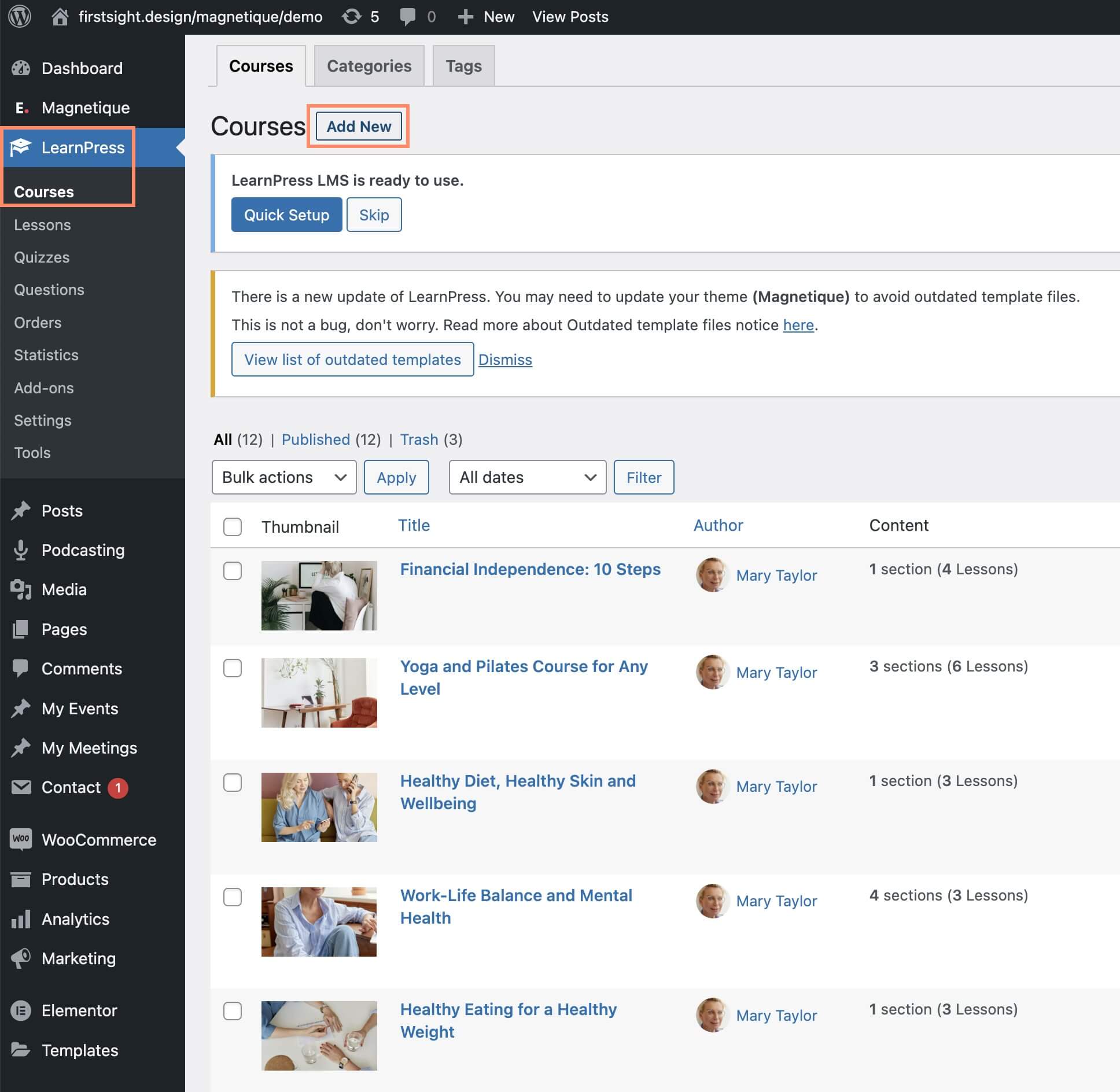
To edit existing course, click on the Edit action link under the course's name and make needed changes in the WordPress edit mode.

To add sections, lessons to a course, scroll down to the Curriculum section and fill in the course agenda.
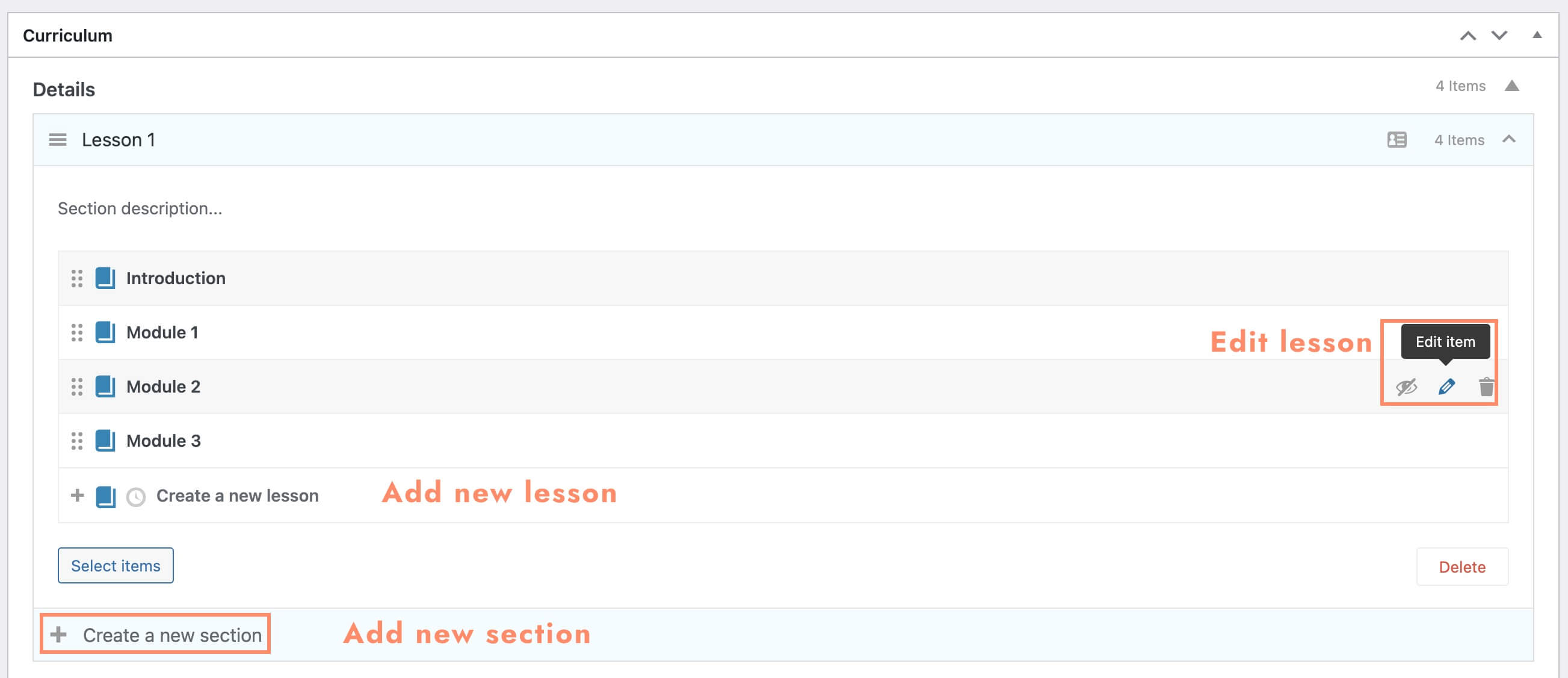
Scroll down to the Course Settings section and set up the course.

To view, edit and create new lesson, go to the LearnPress > Lessons.
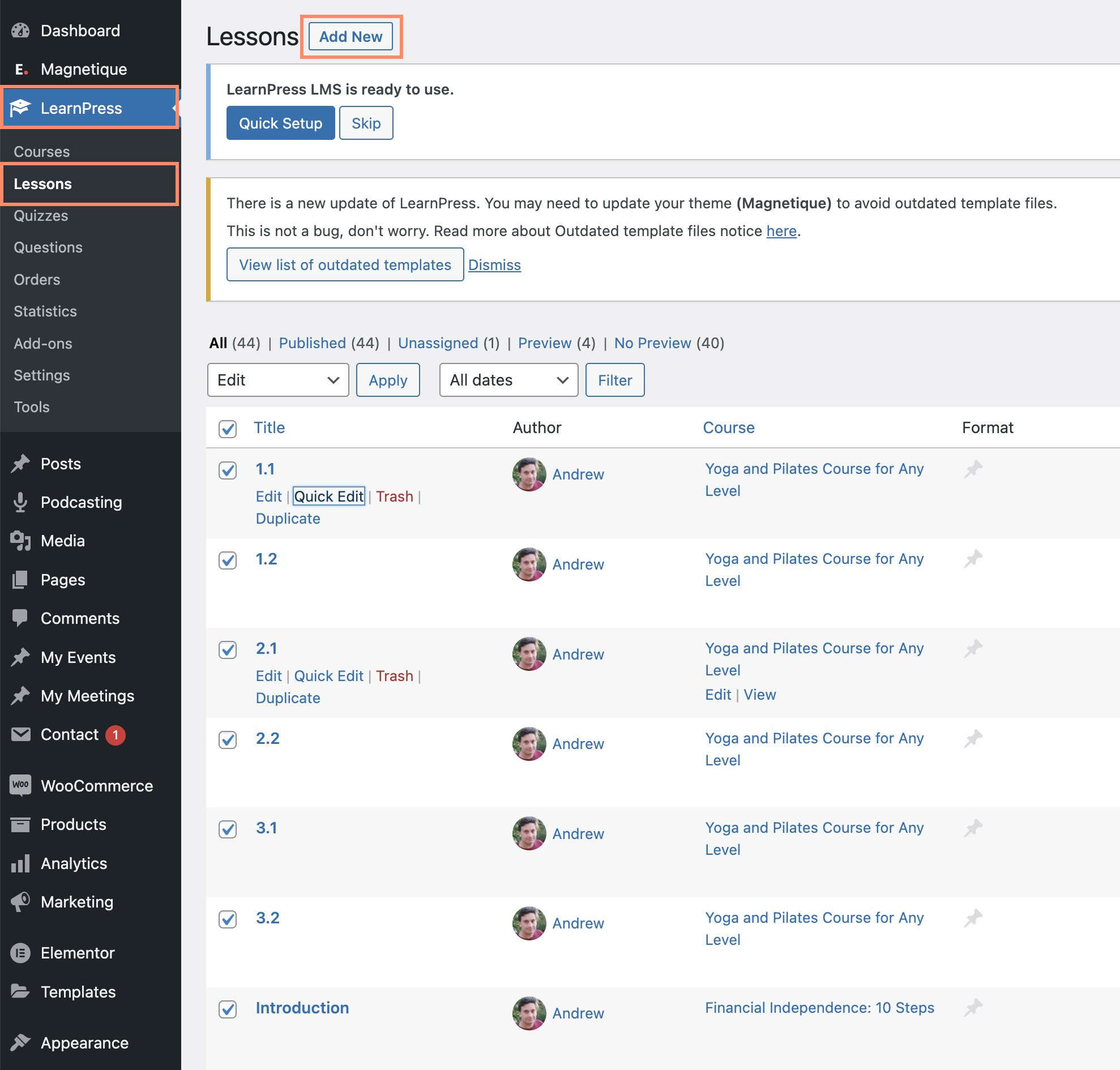
To edit courses categories and tags, go to the LearnPress > Lessons and choose Categories or Tags tab.

To change the author of the course, go to the Course details page and open it in the Edit mode, scroll down to the Course Settings > Author section. Here you can change the author of the course. You can choose from users you've added to your WordPress website.
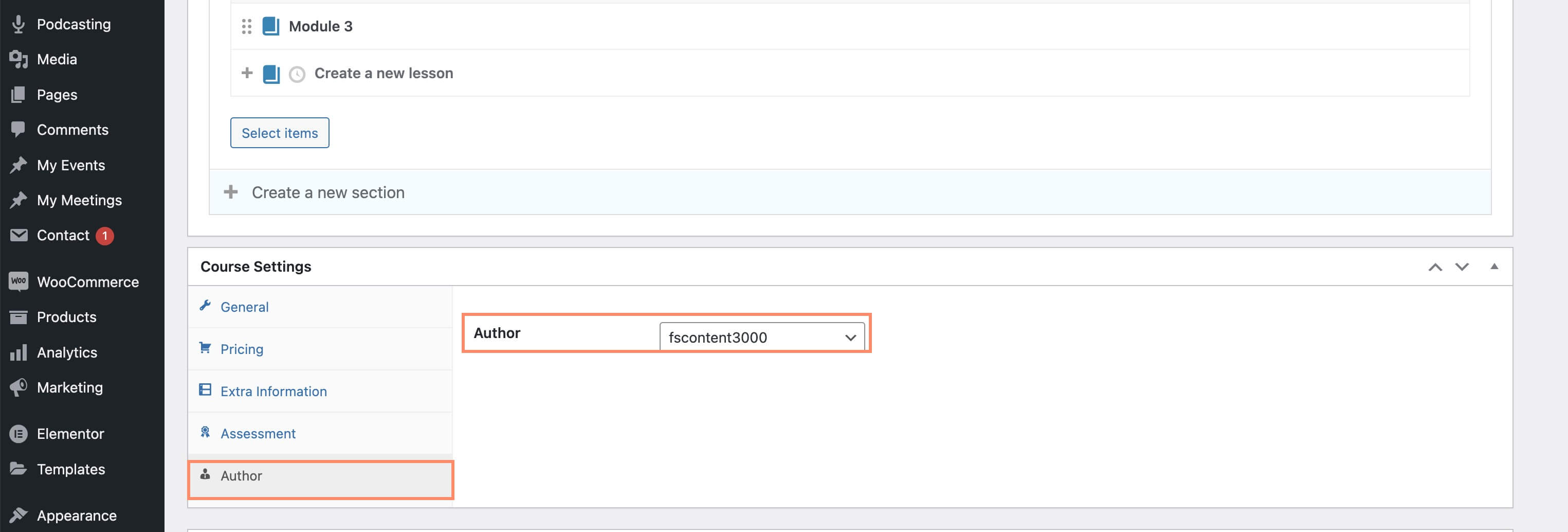
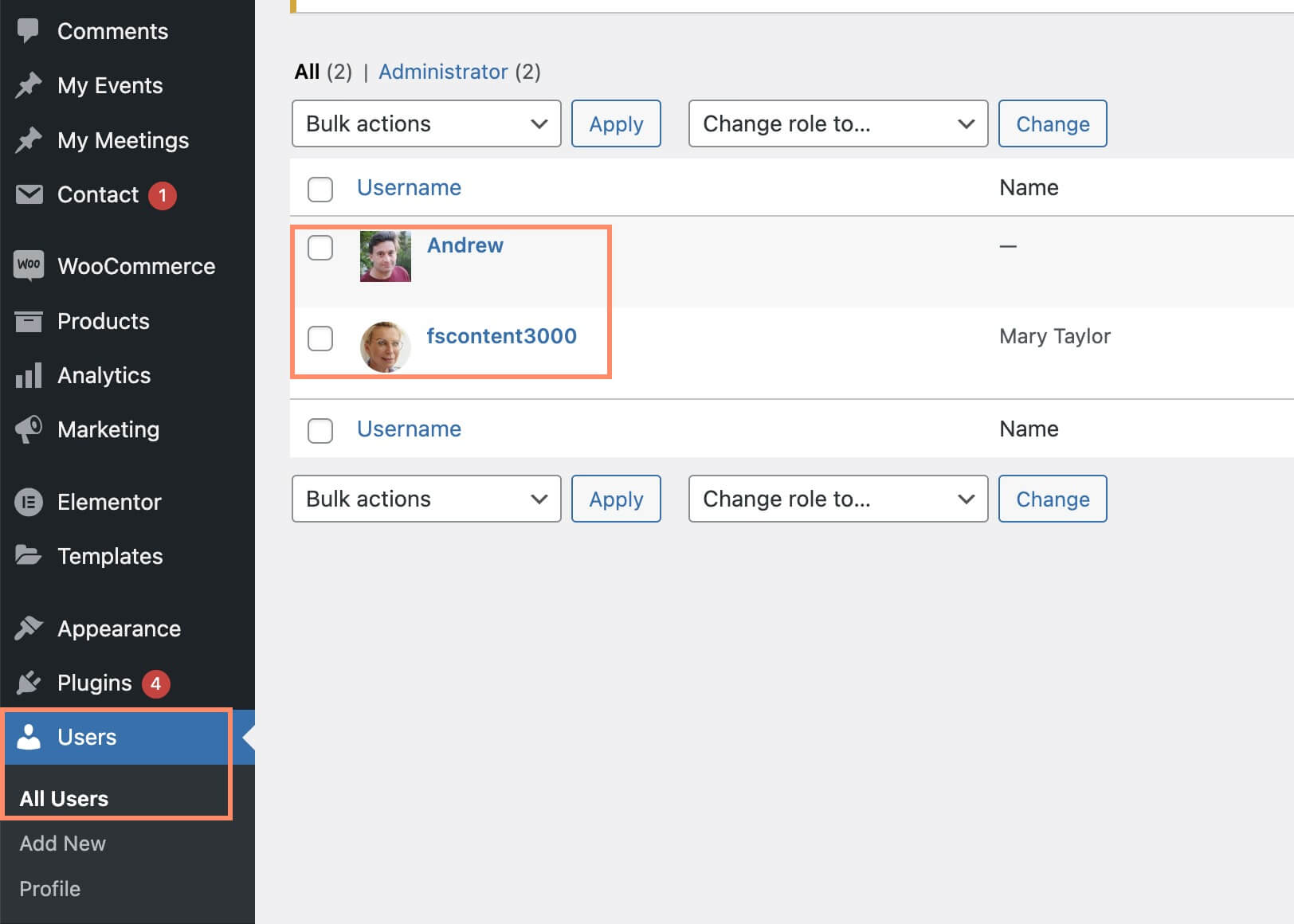
8. Amelia Appointment Booking Plugin
Magnetique theme is compatible and comes with Amelia: Appointments and Events WordPress Booking Plugin. You can use the full functionality of the plugin with the theme. If you’ve received an alert about a plugin that needs to be updated, this could be because the plugin was recently updated. Unless you have purchased the plugin separately, we will provide the latest version of the plugin with the next theme update.
You can find all information about functionality and documentation of Amelia plugin on wpamelia.com.
Note! If you need a service for installing, configuring, or maintaining Amelia plugin, or access to auto-updates or support, you will need to purchase the license separately, directly from plugin authors website and submit a ticket to Amelia’s support.
Amelia plugin can only be used with the theme it cames with (it cannot be extracted or used with other themes)
In order to change the settings of the plugin, go to your admin panel and select Amelia. Here you can find all the settings for the Amelia plugin. Learn more about Amelia plugin settings in the documentation.

In order to style your appointment booking widget, go to your admin panel, select Amelia > Customize > Step-by-Step Booking Form and change the colors. If you want to use the same colors as in the demo, follow next. On the right panel in Settings go to Global Settings > Colors.
Primary and state colors Primary Color: rgba(0, 0, 0, 1)
Sidebar Background Color: rgba(253, 249, 248, 100) Text Color: rgba(0, 0, 0, 1)
Calendar Init Cell: rgba(3, 72, 59, 100) Init Cell Text: rgba(0, 48, 39, 100) Cell Selected Background: rgba(0, 48, 39, 100)
Buttons Primary Button Background Color: rgba(0, 48, 39, 100) Primary Button Text Color: rgba(255, 255, 255, 1)
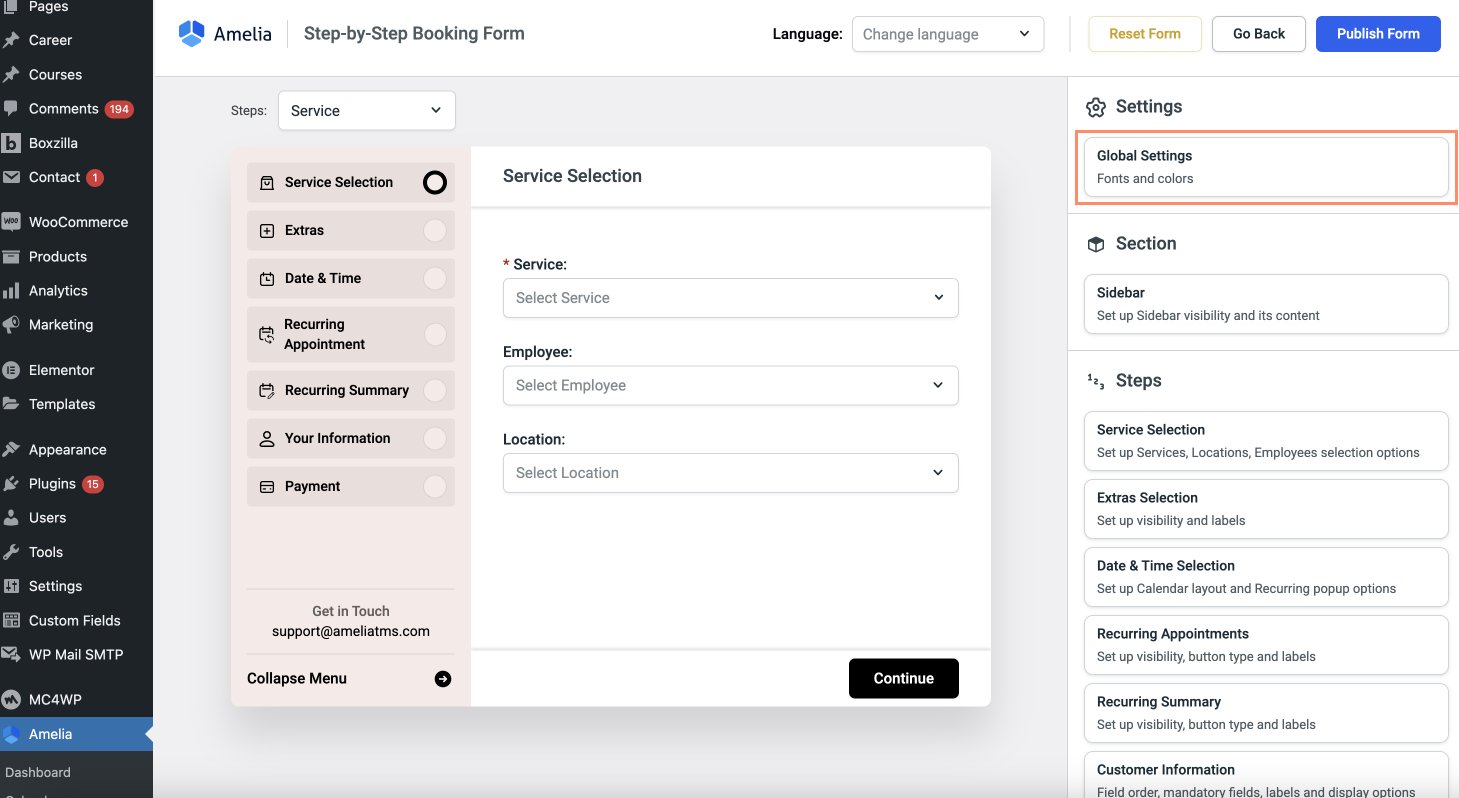
You can add Amelia plugin with a shortcode. Learn more about all possible shortcodes wpamelia.com/amelia-shortcodes.
Or use one of default Amelia widgets or custom Amelia Booking widget for Elementor.
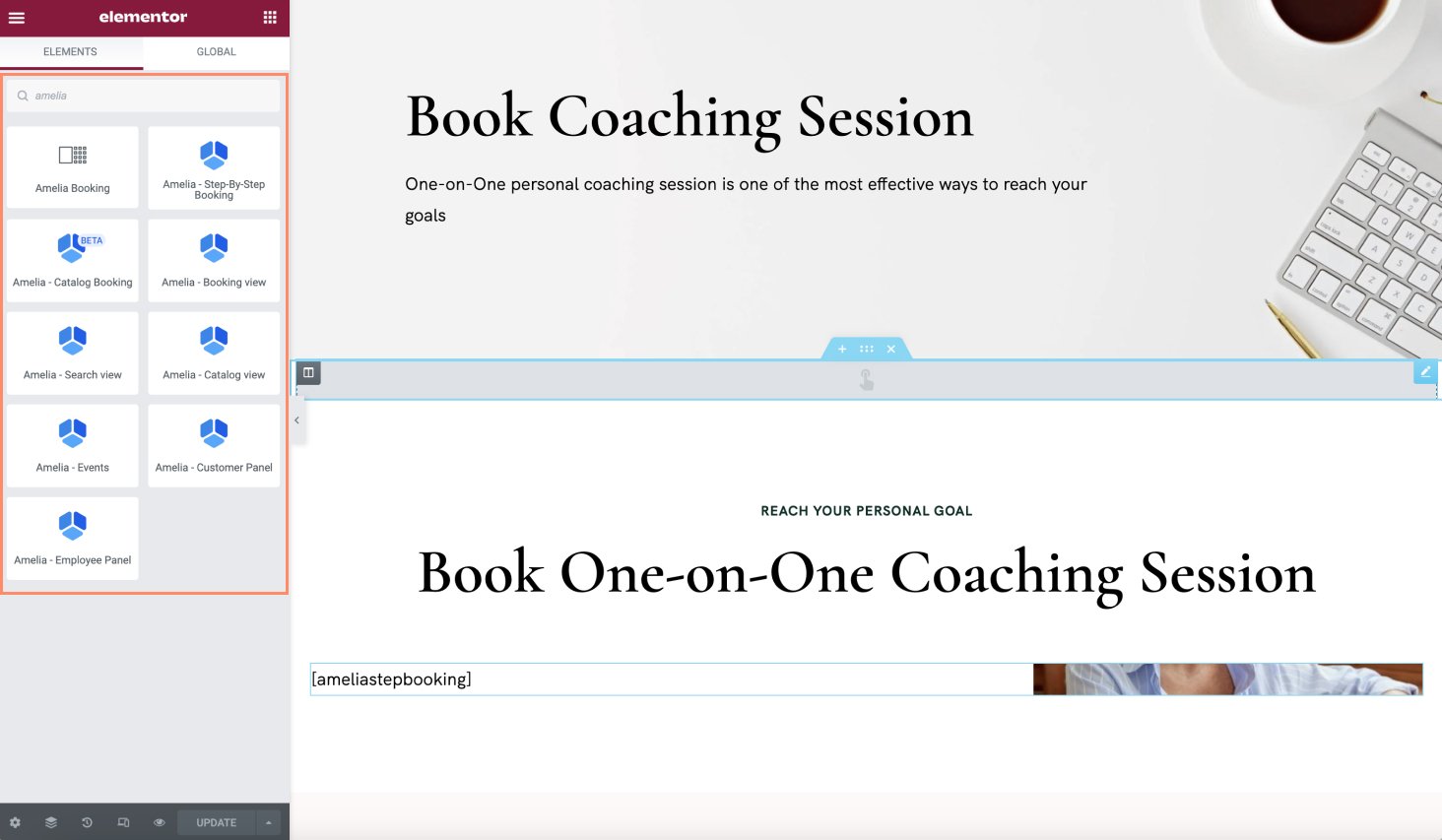
9. Mailchimp for WordPress Plugin
First of all, you have to install Mailchimp for WordPress plugin. The author is ibericode. If you have followed our instructions on how to install the theme, all the plugins including this one should have been already installed and activated. Cherie theme is developed using this plugin, however, if you want to use another one, it is fine.
Go to the Admin panel > MC4WP > Mailchimp and provide your API key. If you do everything right, you will see status Connected.

19. Contact Form 7
For the detailed information about the Contact Form 7 plugin, please read the official guide here.
11. Multilingual Settings
12. WordPress
Since WordPress is constantly being updated information about how to install WordPress may become out of date, so you can always read the official guide here.
Here you can find some useful links about the WordPress:
WordPress Codex – general info about WordPress and how to install it on your server.
First Steps With WordPress – general information that covers a wide variety of topics.
FAQ New To WordPress – the most popular FAQ’s regarding WordPress.
13. GDPR
We suggest using Complianz – GDPR/CCPA Cookie Consent plugin. Complianz is a GDPR/CCPA Cookie Consent plugin that supports GDPR, DSGVO, CCPA and PIPEDA with a conditional Cookie Notice and customized Cookie Policy based on the results of the built-in Cookie Scan.




